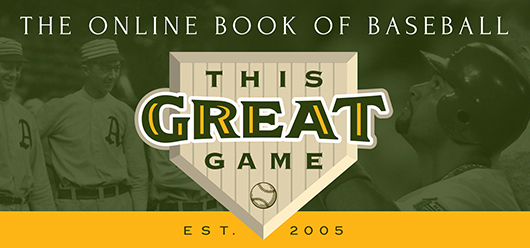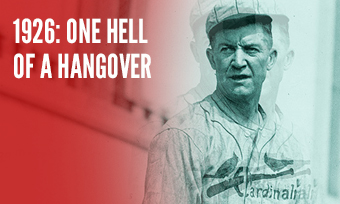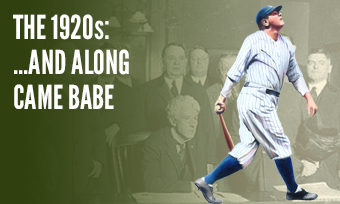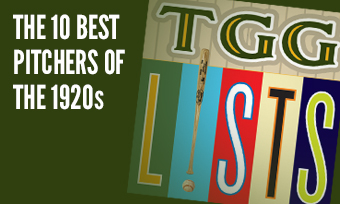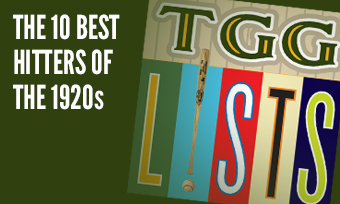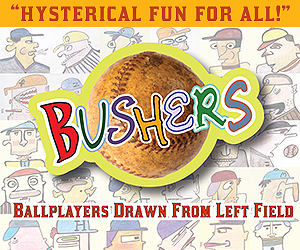The Yearly Reader
Leaders and Honors, 1926
Our list of baseball’s top 10 hitters and pitchers in both the American League and National League for the 1926 baseball season, as well as the awards and honors given to the game’s top achievers of the year.
The National League’s Top 10 Hitters, 1926
Bold type in brick red indicates league leader.
1. Hack Wilson, Chicago
Key Numbers: .321 average, 97 runs, 170 hits, 36 doubles, 8 triples, 21 home runs, 109 RBIs, 69 walks, .539 slugging percentage.
Wilson busted out in Chicago after the Giants lost him through a very costly clerical error (though some say New York manager John McGraw wanted him gone, anyway).
2. Paul Waner, Pittsburgh
Key Numbers: .336 average, 101 runs, 180 hits, 35 doubles, 22 triples, 8 home runs, 79 RBIs, 66 walks, .413 on-base percentage.
“Big Poison” began his career with an average that, under today’s rules, would have won him the batting crown—but Cincinnati catcher Bubbles Hargrave was given the official title instead, even though he batted just 326 times during season.
3. Jim Bottomley, St. Louis
Key Numbers: .299 average, 98 runs, 180 hits, 40 doubles, 14 triples, 19 home runs, 120 RBIs.
After hitting .350 through the first three-plus years of his major leaguer career, Sunny Jim dropped below the .300 mark for the first time—but was still potent enough to lead the NL in RBIs and doubles.
4. Billy Southworth, New York-St. Louis
Key Numbers: .320 average, 99 runs, 16 home runs, 99 RBIs.
Not only did the future Cardinals manager give St. Louis the better of a midseason trade that sent so-so Heinie Mueller to the Giants, but he rubbed in with a pennant-clinching homer at New York on September 24.
5. Kiki Cuyler, Pittsburgh
Key Numbers: 157 games, .321 average, 113 runs, 197 hits, 31 doubles, 15 triples, 8 home runs, 92 RBIs, 35 stolen bases.
On the eve of his fall from grace at Pittsburgh, Cuyler remained the NL’s biggest overall offensive threat.
6. Les Bell, St. Louis
Key Numbers: .325 average, 189 hits, 33 doubles, 14 triples, 17 home runs, 100 RBIs.
Peaking in 1926 before a gradual decline at age 25, Bell collected a higher average than any other Cardinal—yes, even higher than Rogers Hornsby.
7. Rogers Hornsby, St. Louis
Key Numbers: .317 average, 96 runs, 34 doubles, 11 home runs, 93 RBIs, 61 walks.
While we’re on the subject of the Rajah, the future Hall of Famer’s .317 average paled in comparison to the .390 he otherwise hit during the 1920s—and his 11 homers also were the fewest he smacked during the decade. Still, he managed the Cardinals to their first world title.
8. Edd Roush, Cincinnati
Key Numbers: .323 average, 95 runs, 182 hits, 37 doubles, 10 triples, 7 home runs, 79 RBIs.
The long-time Red finished off his tenure before being sent to New York, where the Giants’ John McGraw badly wanted him; he returned briefly in 1931, just long enough to slip below Cy Seymour for the highest modern-era career average in Reds history.
9. George Grantham, Pittsburgh
Key Numbers: .318 average, 27 doubles, 13 triples, 8 home runs, 70 RBIs, 60 walks.
The dependable yet frequently unacknowledged first baseman was one of five Pirate regulars to hit over .300—and one of four to co-lead the team with eight homers.
10. Babe Herman, Brooklyn
Key Numbers: .319 average, 35 doubles, 11 triples, 11 home runs, 81 RBIs.
The rookie hit well over .350 into July before cooling off; of course, everyone will best remember his “doubling into a double play” when he was caught at third base with two fellow baserunners.
The American League’s Top 10 Hitters, 1926
1. Babe Ruth, New York
Key Numbers: .372 average, 139 runs, 184 hits, 30 doubles, 47 home runs, 153 RBIs, 144 walks, .516 on-base percentage, .737 slugging percentage.
The Bambino returned to the Yankees’ good graces with a patented Ruthian onslaught—and once again came oh-so-close to snagging an AL triple crown (losing the batting race to Heinie Manush by just six points).
2. Lou Gehrig, New York
Key Numbers: .313 average, 135 runs, 179 hits, 47 doubles, 20 triples, 16 home runs, 112 RBIs, 105 walks.
Playing his first season every day from start to finish, the Iron Horse would hit the fewest number of home runs in his career—but would collect a personal-best 20 triples.
3. Goose Goslin, Washington
Key Numbers: .354 average, 105 runs, 201 hits, 26 doubles, 15 triples, 17 home runs, 108 RBIs.
Cavernous Griffith Stadium continued to do its best to obscure Goslin’s power numbers; the muscular Senator hit all 17 of his homers on the road.
4. Al Simmons, Philadelphia
Key Numbers: .341 average, 90 runs, 199 hits, 53 doubles, 10 triples, 19 home runs, 109 RBIs.
In his third season, Simmons finally took a day off after playing in 394 straight games to start his career—an AL record that stood until Hideki Matsui in 2006.
5. Harry Heilmann, Detroit
Key Numbers: .367 average, 90 runs, 184 hits, 41 doubles, 8 triples, 9 home runs, 103 RBIs, 67 walks.
If it’s an even year, it must have been a season between batting titles for Heilmann—who still was good enough to finish third in the AL batting race.
6. Heinie Manush, Detroit
Key Numbers: .378 average, 95 runs, 188 hits, 35 doubles, 8 triples, 14 home runs, 86 RBIs.
Manush was obviously good enough to make Detroit manager-center fielder Ty Cobb demote himself to a part-timer.
7. George Burns, Cleveland
Key Numbers: .358 average, 97 runs, 216 hits, 64 doubles, 4 home runs, 114 RBIs.
The man who set the major league record for doubles (later tipped by Earl Webb) won the AL MVP award in part because Babe Ruth, by virtue of being a previous winner, was ineligible.
8. Johnny Mostil, Chicago
Key Numbers: .328 average, 120 runs, 197 hits, 41 doubles, 15 triples, 79 walks, 10 hit-by-pitches, 35 stolen bases.
Mostil peaked as the White Sox’ leadoff man a year before news of his affair with teammate Red Faber’s wife led to a suicide attempt.
9. Bibb Falk, Chicago
Key Numbers: .345 average, 86 runs, 195 hits, 43 doubles, 8 home runs, 108 RBIs, 66 walks.
The Austin, Texas native put up numbers reminiscent of the man he replaced in left field: The expelled Joe Jackson.
10. Tris Speaker, Cleveland
Key Numbers: .304 average, 96 runs, 52 doubles, 8 triples, 7 home runs, 88 RBIs, 94 walks.
In his final season as Indians player-manager before age-old game-fixing allegations caught up to him, Speaker continued to plug away at age 38.
The National League’s Top 10 Pitchers, 1926
1. Carl Mays, Cincinnati
Key Numbers: 3.14 ERA, 19 wins, 12 losses, 281 innings, 24 complete games, 34 grounded into double plays.
The controversial pitcher’s on-and-off history of late was on again, a year after being restricted to 12 appearances and a 3-5 record; he would be off for the next three seasons as he entered his late 30s before stepping away from the game.
2. Charlie Root, Chicago
Key Numbers: 2.82 ERA, 18 wins, 17 losses, 271.1 innings.
After a failed audition with the St. Louis Browns in 1923, Root returned to the majors as a top rookie pitcher with the Cubs—and absorbed more losses than any other National Leaguer despite earning the circuit’s second-best ERA.
3. Ray Kremer, Pittsburgh
Key Numbers: 2.61 ERA, 20 wins, 6 losses, .769 win percentage.
After a slow start owing to shoulder pain, Kremer went 15-3 over the final three months to secure his first of back-to-back ERA crowns.
4. Guy Bush, Chicago
Key Numbers: 2.86 ERA, 13 wins, 9 losses.
Right behind Root in the ERA race was Bush, who continued to contribute more from the bullpen than within the rotation (35 appearances, 15 starts).
5. Pete Alexander, Chicago-St. Louis
Key Numbers: 3.05 ERA, 12 wins, 10 losses.
The old warrior’s season was rescued as he went from frustrated head-butting with Cubs manager Joe McCarthy to World Series legend for the Cardinals.
6. Flint Rhem, St. Louis
Key Numbers: 3.21 ERA, 20 wins, 7 losses, .741 win percentage, 258 innings.
The colorful hurler—who could drink as much as the next guy, Alexander included—found his footing after a rough first two years in the majors (10-15 record, 4.85 ERA).
7. Jesse Petty, Brooklyn
Key Numbers: 2.84 ERA, 17 wins, 17 losses, 275.2 innings.
Petty picked up the slack for a slumping Dazzy Vance and Burleigh Grimes in Brooklyn.
8. Pete Donohue, Cincinnati
Key Numbers: 3.37 ERA, 20 wins, 14 losses, 47 appearances, 36 starts, 5 shutouts, 285.2 innings, 39 walks.
Along with Mays, Donohue effectively wound it up on the mound at Cincinnati before winding down as over-the-hill material.
9. Virgil Barnes, New York
Key Numbers: 2.87 ERA, 8 wins, 13 losses, 185 innings.
With one of the league’s best ERAs—yet a subpar that record—not only did Barnes win the hard-luck award for the year, but for the decade; no NL/AL hurler had a lower ERA with a lower win percentage during the 1920s.
10. Hal Carlson, Philadelphia
Key Numbers: 3.23 ERA, 17 wins, 12 losses, 267.1 innings.
A former spitballer who couldn’t get grandfathered when the wet pitch became illegal, Carlson must have been discretely lathering up the ball to get the kinds of numbers shown above while playing at an absolutely live park (Baker Bowl).
The American League’s Top 10 Pitchers, 1926
1. Lefty Grove, Philadelphia
Key Numbers: 2.51 ERA, 13 wins, 13 losses, 45 appearances, 33 starts, 258 innings, 194 strikeouts.
The sophomore phenom introduced himself to a place he’d become very familiar with—the top spot among AL ERA contenders—thanks to a major cutdown in walks.
2. Ted Lyons, Chicago
Key Numbers: 3.01 ERA, 18 wins, 16 losses, 283.2 innings.
The right-hander walked twice as many batters (106) as he struck out (51), but only two other pitchers allowed a lower batting average (.252).
3. George Uhle, Cleveland
Key Numbers: 2.83 ERA, 27 wins, 11 losses, .711 win percentage, 36 starts, 32 complete games, 318.1 innings, 118 walks, 8 wild pitches, 13 hit-by-pitches.
Nobody allowed more hits and walks in the majors than Uhle, yet the Indians workhorse was still at his sterling best.
4. Herb Pennock, New York
Key Numbers: 3.62 ERA, 23 wins, 11 losses, 266.1 innings, 43 walks.
The veteran southpaw scored a career high in wins, adding two more in the World Series.
5. Eddie Rommel, Philadelphia
Key Numbers: 3.08 ERA, 11 wins, 11 losses.
Like Lefty Grove above, Rommel certainly deserved better than a .500 record.
6. Jack Quinn, Philadelphia
Key Numbers: 3.41 ERA, 10 wins, 11 losses, 31 appearances, 21 starts, 163.2 innings.
Still effective at age 43, Quinn began the trend of fortysomethings dotting the A’s lineup, as he’d be joined in the next couple of seasons by Ty Cobb, Eddie Collins and Tris Speaker.
7. Urban Shocker, New York
Key Numbers: 3.38 ERA, 19 wins, 11 losses, 258.1 innings.
Shocker electrified anew in New York City for the Yankees, who righted the previous wrong of trading him off to the Browns in 1918.
8. Garland Buckeye, Cleveland
Key Numbers: 3.10 ERA, 6 wins, 9 losses.
The great-grandfather of future major leaguer pitcher Drew Pomeranz, Buckeye slipped into the list despite an underwhelming record—and because of his stifling ability to keep runners off base. His gem among gems was a two-hit shutout of the mighty Yankees—walking 10, four of which came against Babe Ruth (who went 0-for-0).
9. Firpo Marberry, Washington
Key Numbers: 3.00 ERA, 12 wins, 7 losses, 22 saves, 64 appearances, 5 starts.
Baseball’s first realization of the closer set his own record for saves; it would be 23 years before someone else (the Yankees’ Joe Page) would reset the mark.
10. Stan Coveleski, Washington
Key Numbers: 3.12 ERA, 14 wins, 11 losses.
At age 37, Coveleski performed one last admirable campaign before his arm petered out.

